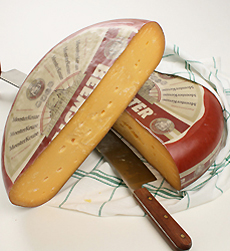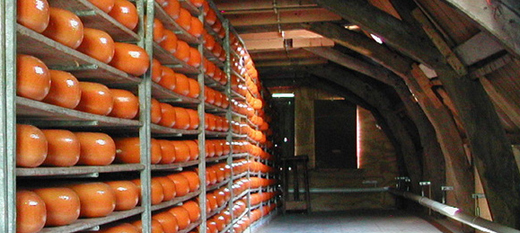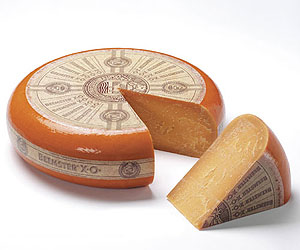

Beemster is a Gouda made exclusively in the quiet, canal lined pastures of North Holland, 20 feet below sea level. Master’s Choice, shown above, is one of several varieties of Beemster.
March 2009
|
 |
Beemster Cheese
Page 2: How Beemster Cheese Is Made
This is Page 2 of a two-page article. Click on the black links below to visit Page 1.
How Beemster Cheese Is Made
The special care devoted to the treatment of Beemster cows continues with the crafting of the cheese itself. First, the milk is continuously tested when it arrives at the dairy from the individual farms. Rennet is then added to the milk to facilitate the coagulation of curds. Next, the curd is cut, pumped into open drainage containers and raked out by hand, a process most cheese makers leave to mechanization.
After the whey drains, the Beemster curd is placed into molds in which they are pressurized into the wheel shape. The wheels are placed into a brine bath, which starts the aging process from within the cheese. Then the wheels are aged on wooden boards in traditional temperature and humidity-controlled warehouses, where they’re hand-turned, inspected and polished every day for up to 26 months.

Wheels of Beemster aging. Photo courtesy of Beemster.us.
Cheese Terms
Here are cheese terms relevant to this article. For more cheese terms, see our Cheese Glossary.
Artisan Cheese: A cheese made in small batches, using traditional techniques—it refers to the manner in which the cheese is made. As little mechanization as possible is used in the production of the cheese.
Brine-Cured: Many types of cheese are washed with, or submerged into, a brine bath as part of the cheese making process. The brining solution provides cheese with a slightly salty flavor and helps to limit the growth of unwanted bacteria that can produce a foul taste in the cheese (in other stages of the cheese making process, beneficial bacteria are necessary for producing the positive, character-giving qualities of the cheese). Appenzeller, Feta and Parmigiano-Reggiano are other examples of brine-cured cheese.
Curds: Cheese is made of curds, which are obtained by curdling (coagulating) milk with rennet (an enzyme) or an acid such as lemon juice or vinegar; then draining off the whey. The milk solids become curds when an acid (vinegar, lemon juice) or enzymes are added.
Rennet: Rennet is a coagulating enzyme that is added to milk as the first step in making cheese. The traditional source of rennet is the abomasum (fourth stomach or rennet stomach) of slaughtered, milk-fed new-born calves or other young ruminants. It is also possible to produce rennet from fungi.
Whey: Whey is the liquid portion of milk, after the solids (protein and fat) have been extracted.
BEEMSTER CHEESE
Classic, Flavored, Master’s Choice, X-O
- 8 Ounces
$5.39 To $8.99
Depending On Variety
Buy online* at
iGourmet.com
Photo: Beemster X-O, mature with
butterscotch flavors.
Go To The Article Index Above
|
 |
*Prices and product availability are verified at publication but are subject to change. Shipping is additional. These items are offered by a third party and THE NIBBLE has no relationship with them. Purchase information is provided as a reader convenience.
Lifestyle Direct, Inc. All rights reserved. Images are the copyright of their respective owners.

|






